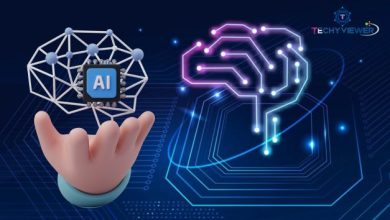How AI is Transforming Data Extraction and Document Management
In today’s competitive business landscape, data is a gold mine. However, many organizations still rely on outdated, inefficient, and error-prone methods for data management.
According to a McKinsey report, employees spend nearly 1.8 hours daily– approximately 20% of their work time– searching and gathering information.
This inefficiency presents a significant opportunity for AI to revolutionize how businesses manage data processes.
AI solutions have the potential to create competitive advantages and enhance business performance.
This article will explore how advanced Artificial Intelligence technologies are reshaping the field of data extraction and document handling.
AI Technologies Used in Data Extraction
Document digitization refers to the process of converting physical paper records into digital versions, such as PDF documents and scanned images. Document digitization process enhances accessibility, improves security, and reduces costs.
Here are some commonly used AI technologies in Data Extraction:
Optical Character Recognition (OCR): OCR technology converts image files, documents, faxes, or PDF files into editable texts. A key application of OCR is handling complex documents, such as those with low-quality scans or random fonts.
Natural Language Processing (NLP): NLP is a branch of AI focused on enabling machines to better understand human language. In document management, NLP is used in text mining to extract the necessary data from textual content, facilitating the efficient management of large information collections.
Machine Learning (ML): Machine learning algorithms learn from data and improve over time, making them highly effective for extracting information from databases. ML allows organizations to analyze and process data correctly and timely, identifying patterns and trends that may be challenging to recognize but are quickly detected by ML.
Deep Learning: Deep learning is a subset of ML that involves neural networks with multiple layers that can learn and make decisions independently. Deep learning is particularly effective in detecting patterns and anomalies in large databases, making it a powerful tool for data extraction and document management.
Also Read: Behind the scenes: How Twilio is changing the tech industry
Applications of AI in Document Processing
Computing technologies like AI are widely used and highly relevant in document processing. Here are some examples:
Automated Data Entry
AI can independently handle data entry tasks, reducing the workload of human workers. This automation minimizes errors associated with manual data entry, resulting in more accurate and reliable outcomes.
Data Extraction from Unstructured Documents
AI excels in processing unstructured documents, such as invoices, purchase orders, reports, and PDF files. It can identify and extract critical information, converting textual data into structured format. This significantly reduces the time needed to analyze large volumes of data.
Document Classification
AI can streamline the classification of documents, enhancing the process of information retrieval. This capability improves efficiency in locating documents relevant to specific projects, thereby boosting productivity in data management tasks.
Sentiment Analysis
AI’s sentiment analysis can evaluate the tone and sentiment of customer-facing documents, such as feedback form for support tickets. By understanding customer satisfaction and complaints, businesses can take appropriate actions to better meet customer needs.
Benefits of Using AI for Data Extraction and Document Processing
The benefits of AI in document processing extend across various aspects of business operations:
Increased Accuracy and Efficiency
The use of AI primarily in data extraction and documentation may significantly minimize errors since it handles all the data processing with great precision.
This leads to improved data quality when used in decision-making; on the other hand, it makes some tasks more efficient, thus allowing the workers to concentrate on more critical activities.
Cost Savings
Due to machine learning, the number of manual hours that would otherwise be spent in executing the task is considerably reduced; hence, costs are cut.
Employing the services of a document management solution frees up the time employees previously spent on manual filing and sorting, allowing them to focus on more valuable tasks and boosting the company’s revenues in the process.
Scalability
AI solutions are always more scalable and work well on both small sets of data and large sets of data with similar effectiveness. With the gradual expansion of your business, Document processing through AI can easily accommodate the increased amounts of data that have to be processed.
This scalability allows the document management processes to be in line with business expansion, thus offering reliable results.
Improved Data Accessibility
AI makes work related to organizing, storing, and retrieving documents easier because it makes data easily accessible. By using AI, corporate entities can easily and efficiently search and filter large volumes of data for better decision-making and a proactive response to changes in market conditions.
This improved accessibility also enhances cross-team working since any team can post and share relevant documents and use them as references.
Also Read: Ai-Writer: Transforming Content Creation With Artificial Intelligence
Challenges and Considerations
Despite its advantages, AI implementation in document management comes with certain challenges.
Data Privacy and Security: As with any technology handling sensitive information, the security and confidentiality of the data must be controlled.
Integration with Existing Systems: AI may be applied in a company directly or integrated into the existing systems, so its deployment must fit well into the existing IT architecture.
Handling Diverse Document Formats: AI systems are supposed to handle document formats of various types, from pure text and Word to PNG and PDF with many images. This necessitates the use of advanced algorithms that can work well regardless of the kind of information passed to it.
Ensuring Data Quality: The effectiveness of AI in document management depends on the quality of the data being processed. Businesses must implement strategies to ensure that their data is accurate, up-to-date, and free from inconsistencies.
See How AI has Streamlined Data Extraction for a Renowned Financial Firm
KlearStack’s AI-driven platform has revolutionized the way businesses approach data extraction and document management. By integrating advanced OCR (Optical Character Recognition), NLP (Natural Language Processing), and ML (Machine Learning) technologies, KlearStack has provided businesses with a more efficient and accurate method for handling various documents.
One of India’s leading banks and major financial institutions processes consumer durable loans. The bank has 800+ branches across India.
Background
The bank processes more than 3 lakhs consumer loans every month. In order to process the data at various loan stages, they had to extract the data from multiple documents. The list of documents includes consumer durable invoices, vehicle invoices, vehicle dealer quotations, handwritten NACH mandate forms, and vehicle insurance policies.
All of these documents were processed manually which led to some significant challenges.
Challenges Faced by the Bank
- Manual document processing led to slow turnaround times.
- Increased labor requirements led to high operational costs.
- Manual processes introduced errors and costly rework.
- There’re prolonged delays in the loan processing which result in discontent customers.
- Dealers faced delays in receiving loaned funds.
- The bank faced challenges in adapting to fluctuating transaction volumes.
The bank wanted to become one of India’s leaders in the consumer loans segment. But the biggest challenge was manual data entry and data validation operations. Extracting information from diverse loan documents and inputting it into their loan-approval system was an intricate, time-consuming task.
If they wanted to increase the business by multifold, they would have to proportionally increase the manpower because it was all manual.
Also Read: The Role of Generative AI in Personalizing Customer Interactions
The Solution
The bank’s app was integrated with KlearStack Solution with the help of KlearStack RESTful APIs. Let’s see how KlearStack has transformed their loan processing?
#1. Document Capture : Sales representatives nationwide capture images of loan-related documents using the bank’s mobile app.
#2. Real-Time Upload: These images are then instantly uploaded to KlearStack via RESTful APIs.
#3. AI-Powered Processing: KlearStack’s advanced technology interprets each document, extracting essential data using proprietary trained ML technology.
#4. Post-Processing Analytics: Post-processing analytics and auditing further improves data quality.
#5. Seamless Integration: The extracted data seamlessly integrates with the bank’s downstream systems, significantly reducing processing time.
Now, KlearStack processes millions of documents per year in online processing mode. Know the transformation brought by KlearStack:
- 100% Improvement in team productivity.
- 300% Times faster loan processing.
- 95% Field level accuracy.
- 85% Straight through processing.
To Wrap it Up!
Artificial intelligence has become one of the main trends in data collection and document processing as it opens immense possibilities for business development to increase productivity, minimize errors, and enhance the capacity for growth.
In the world of data, such restrictions can be eliminated with the help of AI technologies such as OCR, NLP, ML, and deep learning to remain competitive. Thus, the future of AI in the business world has one way to go, and that is upward.



